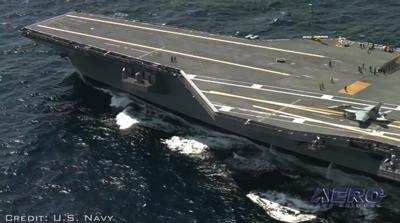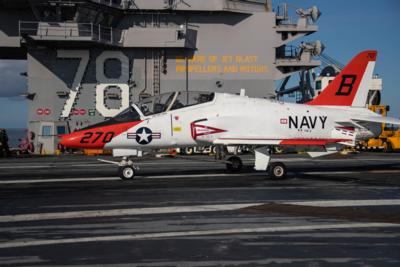Milestone Took Place Onboard USS Gerald R. Ford
Capt. Tracey “PETA” Gendreau, commodore of Training Air Wing 1, hit a personal milestone Feb. 5 when he caught his 1,000th trap aboard aircraft carrier USS Gerald R. Ford (CVN 78) while underway in the Atlantic Ocean off the coast of Florida during a carrier qualification (CQ) detachment.

Whether a pilot is new to the craft or a seasoned veteran with many at-sea deployments under their belt, landing a jet on an aircraft carrier is exhilarating, sometimes terrifying, and is certainly no easy task.
Capt. Tracey “PETA” Gendreau is commodore of Training Air Wing 1 aboard Naval Air Station Meridian, Mississippi. He and his team conduct undergraduate intermediate and advanced strike pilot training for the Navy, Marine Corps, and select international partners. He knows a thing or two about landing on an aircraft carrier (called a trap) because he’s done it a time or two. In fact, he’s done it a thousand times.
Gendreau, a native of Pensacola, Florida, hit a personal milestone Feb. 5 when he caught his 1,000th trap aboard aircraft carrier USS Gerald R. Ford (CVN 78) while underway in the Atlantic Ocean off the coast of Florida during a carrier qualification (CQ) detachment.

“It’s a very special feeling to get number 1,000 on the newest aircraft carrier in the fleet,” Gendreau said. “USS Ford is the third first-in-class CVN (aircraft carrier) I’ve trapped on, along with USS Enterprise and USS Nimitz. The technological advances are amazing, but one thing hasn’t changed. After my 1000th, I just looked around with pride at all of the Sailors who make carrier aviation work. The professionalism and teamwork they have always displayed throughout my career is nothing short of astonishing!”
Gendreau got his first trap aboard USS George Washington (CVN 73) during his CQ detachment as a student naval aviator assigned to the “Eagles” of Training Squadron (VT) 7, one of two squadrons now under his command at Training Air Wing 1. With almost 24 years of Navy experience, he shared advice for students who have just begun their Naval Aviation careers.
“If they’re not having fun, they’re doing something wrong.” Gendreau said. “Flying upside down, pulling Gs, and landing on ships is a great way to earn your pay. Put in the hard work, it’s worth it!”
Gendreau was part of a cadre of 27 instructors from Training Air Wings 1 and 2 that executed the CQ detachment out of Naval Air Station Key West, Florida, led by Chief of Naval Air Training’s lead landing signals officer. Thirty-one student naval aviators enrolled in the Strike training pipeline conducted CQs as one of their final curriculum events in the advanced phase of undergraduate strike pilot training in addition to seven instructors under training. Together, students and instructors conducted 432 launches and recoveries (traps) during the detachment.
Upon completing the curriculum, students earn their Wings of Gold and designation as a naval aviator. Navy graduates progress to graduate-level training in the F/A-18E/F Super Hornet, EA-18G Growler, or F-35C Lightning II at their respective fleet replacement squadron.
Gendreau commissioned in 1997 through Officer Candidate School after graduating from Metropolitan State College of Denver in 1995 with a Bachelor of Science in professional piloting. He earned his Wings of Gold in 1999. He has deployed in support of Operations Southern Watch and Enduring Freedom, Operation Iraqi Freedom, Operation Enduring Freedom, and Operation Inherent Resolve. He flew operationally with the “Black Aces” of Fighter Squadron (VF and VFA) 41, commanded the “Fighting Swordsmen” of Strike Fighter Squadron (VFA) 32, and served as operations officer aboard USS George H.W. Bush in addition to various shore tours. Gendreau has accumulated more than 4,000 flight hours.
Training Air Wings 1 and 2 report to Chief of Naval Air Training (CNATRA), headquartered in Corpus Christi. CNATRA trains the world's finest combat quality aviation professionals, delivering them at the right time, in the right numbers, and at the right cost to a naval force that is where it matters, when it matters.
 ANN's Daily Aero-Term (05.09.24): Hold Procedure
ANN's Daily Aero-Term (05.09.24): Hold Procedure ANN's Daily Aero-Term (05.06.24): Altitude Readout
ANN's Daily Aero-Term (05.06.24): Altitude Readout ANN's Daily Aero-Linx (05.06.24)
ANN's Daily Aero-Linx (05.06.24) Airborne-NextGen 05.07.24: AI-Piloted F-16, AgEagle, 1st 2 WorldView Sats
Airborne-NextGen 05.07.24: AI-Piloted F-16, AgEagle, 1st 2 WorldView Sats Aero-News: Quote of the Day (05.07.24)
Aero-News: Quote of the Day (05.07.24)




